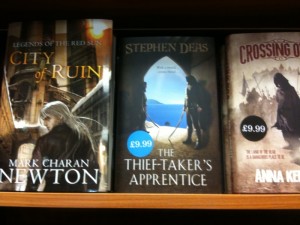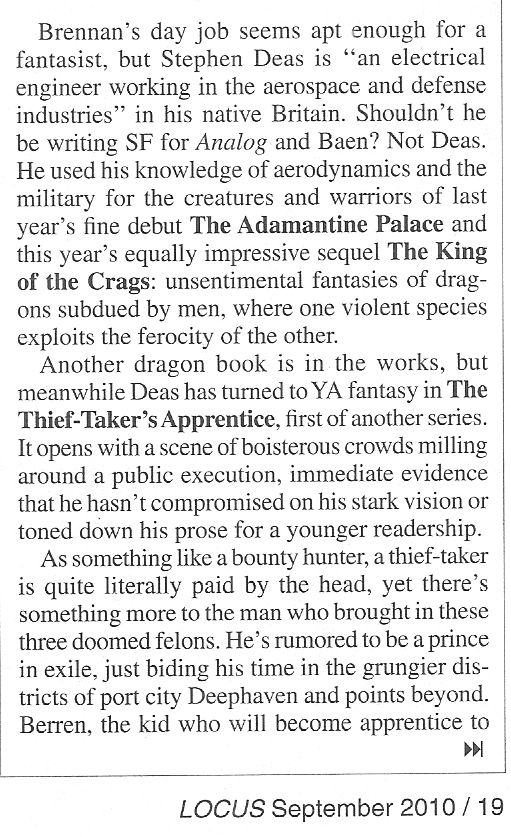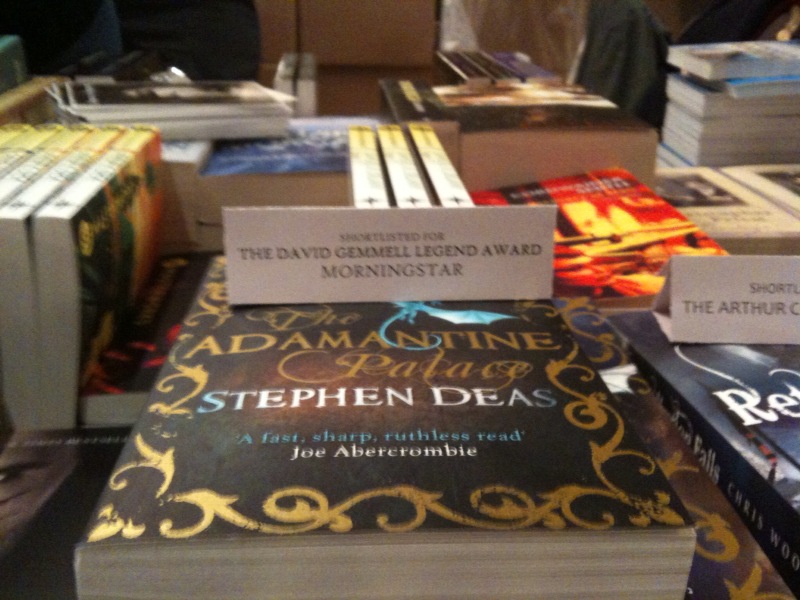Busy busy busy. The Adamantine Palace is coming out in the US in less than three weeks and so there’s interviews and guest blogs and and and… And a copy of the book too, and it’s a hardcover and even prettier in the flesh than it was on a screen. Two suich beautiful covers! How can you choose between them? Order of the Scales re-write number one is going slightly better than expected, the page-proofs for King of the Crags are due in a fortnight and and and…
Then there’s the Gemmel Awards to mention. Go vote! Don’t make Mr Abercrombie mad! And I’ve been reading some other titles due out from Gollancz too. Tome of the Undergates and Wolfsangel. Both will receive some more attention closer to their release dates.
Right now, though, I don’t have time to do justice to anything. So here’s a review I made earlier for Vector for a book you can (and should) go and buy right now.
Yellow Blue Tibia (Gollancz; ISBN 978-0575083578 )
Author: Adam Roberts
World War II is over. The Soviet Union has defeated Hitler and Stalin is convinced that Europe and America will soon fall. Global Soviet peace will follow; and to prepare for that peace, Stalin calls Konstantin Skvorecky and a handful of other Soviet science fiction authors to a secret dacha in the countryside. The new communist world will need some new menace to hold it together, something to give it a unity of cause and purpose. In short, it will need the threat of an alien invasion, and the job of this group of writers is to create one, a fiction but a plausible one. No expense will be spared in staging this invasion. It will begin with the destruction of an American spaceship and a huge explosion in the Ukraine…
When their job is done, the writers are unceremoniously ejected and told to forget what they have done. Mostly they consider themselves lucky not to have been shot.
Fast-forward some forty years. Skvorecky, now ex-SF writer, ex-alcoholic, part-time translator and dedicated cynic finds himself asked to act as a translator for a rather odd pair of Americans. As he leaves, he is approached by the last other survivor of Stalin’s SF cabal, now working in the KGB, who tries to convince him that the alien invasion they created is becoming reality: It’s 1986. The Space Shuttle Challenger has exploded, something is afoot in the Ukraine at Chernobyl, and aliens appear to be secretly invading the world.
So there’s the set-up. Skvorecky quickly acquires a taxi-driving nuclear physicist sidekick and proceeds to be bounced from one slightly bizarre and surreal episode to the next in what is, in the end, an exquisitely crafted and cerebral mystery.
Now, I have this idea that stories engage with readers in two fundamentally different ways. They engage with us on an emotional level, with adrenaline-pumping action, tooth-grinding tension, white-knuckle drama; with love and joy and hate and revenge and possibly too many adjectives. And they engage with us on an intellectual level, with ideas and philosophies that educate and amuse and stimulate and enrich. Yellow Blue Tibia is firmly entrenched at the latter end of the spectrum. Skvorecky and his taxi-driver never emotionally engage with the story in which they find themselves; rather, Skvorecky observes his own trajectory with a detached amusement, while his taxi-driver is a realistic depiction of Asperger’s Syndrome. These are both deliberate choices by the author and, as with everything else here, expertly crafted; in fact, this sort of detachment is probably necessary, as some of the strangeness they encounter would likely drive anyone else (reader included) to distraction trying to work out what could possibly be going on. Right up to the end, it’s not clear whether this is a mundane KGB conspiracy, a comedy of errors, a narrator who’s lost his marbles or whether there are, indeed, some aliens somewhere. Adams seems fascinated with the phenomena of UFOs, the are they-or-aren’t-they of them, the weight of the anecdotal set against the utter lack of hard physical evidence. Yellow Blue Tibia even offers a rather tidy answer.
The real strengths of this book are in the easy flowing prose (I occasionally had to stop and read a scene again simply to admire how well it was put together), in Skvorecky’s sardonic wit and in the marvellous central idea, revealed at the end, which gives almost perfect coherence and sense to all the seemingly random events that precede it.
In summary, the writing is elegant and yet straightforward, the mystery is engrossing and the idea at the core is inspired. Readers after an emotional connection may find it difficult to engage with the story, but for those who are after a piece of old-school science-fiction brain food that makes you think, Yellow Blue Tibia delivers in spades.
(Post review note: I read this in the summer of 2009 and still find myself thinking about it. It’s just such a neat idea. Even if it violates the second law of thermodynamic and thus casts the whole premise into the realms of. . . But no: that’s a battle for another day 




